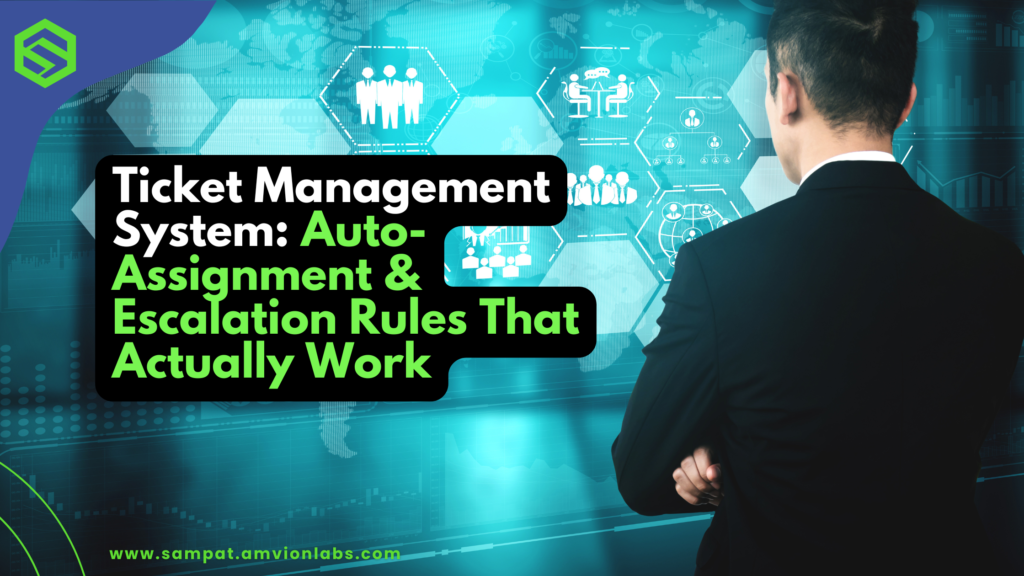
Ticket Management System: Auto-Assignment & Escalation Rules That Actually Work
In the world of customer support and IT services, response time is everything. No matter how skilled your team is, if a ticket sits untouched or bounces between the wrong agents, it causes frustration for both customers and support teams.
That’s where auto-assignment and escalation rules come into play. These are not just “nice-to-haves”—they’re” essential features in a modern ticket management system that actually works. In this blog, we break down why these two components are vital, how they function, and what best practices can elevate your help desk and support operations.
Why Manual Ticket Assignment Falls Short
Picture this: a support team receives 100+ tickets daily. Without automation, someone has to read each one, figure out the right agent or department, and assign it manually. Not only does this delay response time, but it also increases the chance of human error.
This outdated method often results in:
- Delayed response and resolution times
- Unfair workload distribution among agents
- Poor customer satisfaction
- SLA breaches
Auto-assignment and escalation rules help solve these problems at the root.
What is auto-assignment in a ticketing system?
Auto-assignment means that incoming support tickets are automatically routed to the right agents or departments based on predefined rules. Think of it as a smart traffic controller that knows exactly where to send each ticket — instantly and accurately.
Common Auto-Assignment Methods:
- Round-Robin Assignment – Tickets are distributed evenly among available agents.
- Skill-Based Assignment – Tickets are routed to agents based on skill tags (e.g., “network,” “billing,” “product A”).
- Load-Balanced Assignment – Distribution is based on the current workload of each agent.
- Location/Language-Based Routing – Useful for multilingual or region-specific support teams.
Benefits of Auto-Assignment:
- Speeds up first response time
- Eliminates manual errors and bias
- Improves team productivity
- Ensures customers get the most relevant help, faster
✨ Want to see how this works in a real product? Check out SAMPAT’s ticket management system.
What Are Escalation Rules?
Despite automation, certain tickets may still be overlooked without proper follow-up mechanisms. That’s where escalation rules take over.
Escalation rules are predefined workflows that automatically escalate a ticket based on factors like response delays, ticket priority, or customer profile.
Examples of Escalation Triggers:
- A high-priority ticket not responded to within 30 minutes
- A VIP client’s ticket not resolved within 2 hours
- Tickets left in “Open” status beyond a defined SLA time
Types of Escalations:
- Time-Based Escalation – Based on aging of tickets without resolution
- Priority-Based Escalation – Critical or high-priority issues escalate faster
- Skill-Based Escalation – Routed to higher-tier agents or specialists
- Customer-Type Escalation – Different escalation paths for enterprise or high-value customers
Why Auto-Assignment & Escalation Rules Work Better Together
Separately, auto-assignment and escalation improve response and resolution time. But together? They form a support system that is fast, responsive, and customer-first.
Let’s look at a scenario:
A ticket about a software outage from a VIP client is submitted.
– The auto-assignment system routes it immediately to a Tier 2 agent with expertise in outages.
– If the issue isn’t resolved in 60 minutes, the escalation rule kicks in and alerts a supervisor.
– Meanwhile, the client receives proactive updates.
That’s service reliability — made possible through automation.
Best Practices for Setting Up Auto-Assignment
✔ Define Clear Rules – Don’t make rules too broad. Use categories like product, issue type, customer segment, and location.
✔ Use Agent Tags & Skills – Proper tagging helps in better skill-based routing.
✔ Test Assignment Load – Make sure the rules distribute tickets evenly and don’t overload certain agents.
✔ Monitor & Adjust – Analyze performance regularly and fine-tune rules as needed.
Best Practices for Setting Up Escalation Rules
✔ Start with SLA Goals – Base escalations on response and resolution time thresholds.
✔ Implement multi-level escalation – It begin with automated alerts and escalates to senior staff if the issue remains unresolved.
✔ Notify the Right People – Escalation alerts should go to people with authority to act quickly.
✔ Automate Status Updates – Keep customers informed automatically when their issue is escalated.
Key Metrics to Monitor
Once your rules are in place, keep track of:
- Average response time
- First contact resolution rate
- Number of escalations per week
- Agent workload balance
- SLA compliance rate
Tracking these metrics ensures your automation strategy is actually improving support.
Final Thoughts
A modern ticketing system isn’t just a platform to collect issues — it’s your frontline customer experience engine. Auto-assignment and escalation rules are key to ensuring that no ticket goes unanswered, no customer feels ignored, and no team member gets overwhelmed.
These are not just rules; they’re the foundation of a smarter, faster, and more reliable support system.
So, if your current system doesn’t support automation like this, it may be time to upgrade — and SAMPAT has just the solution.


